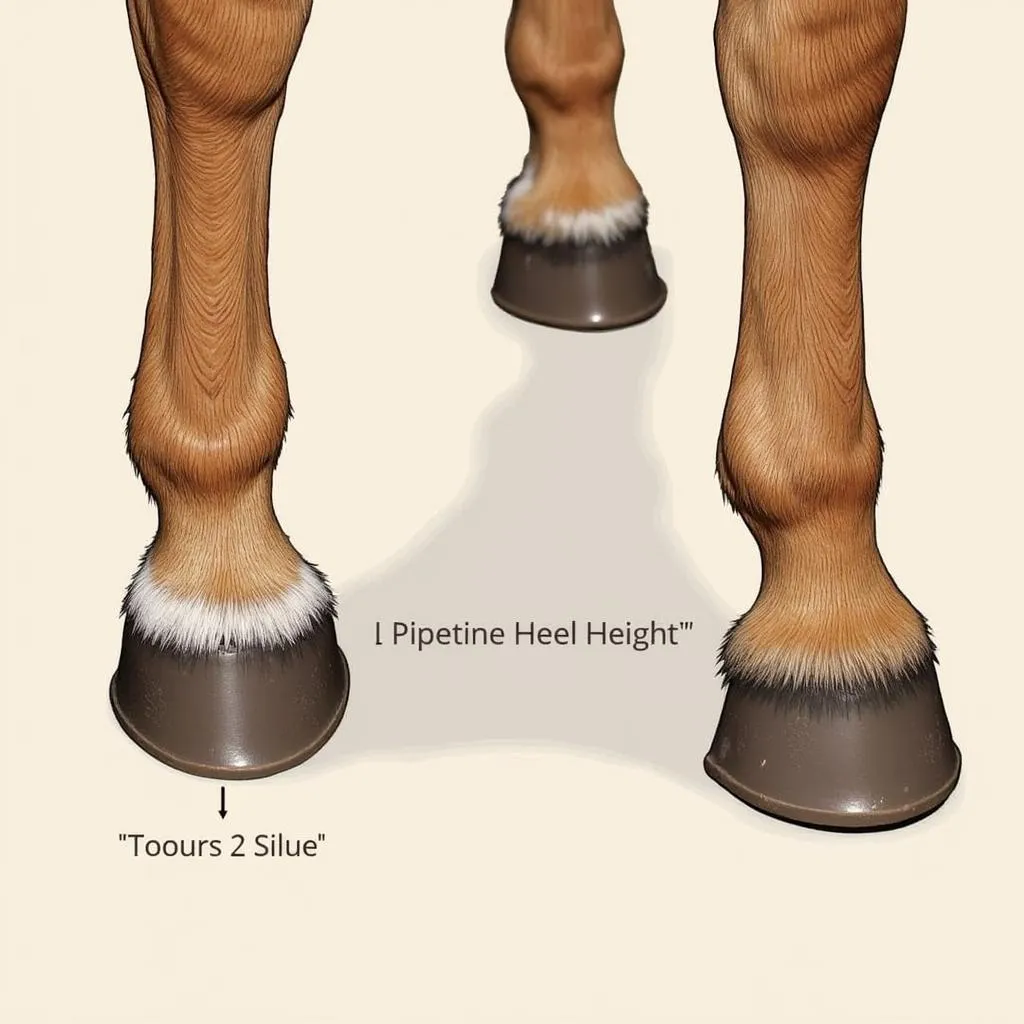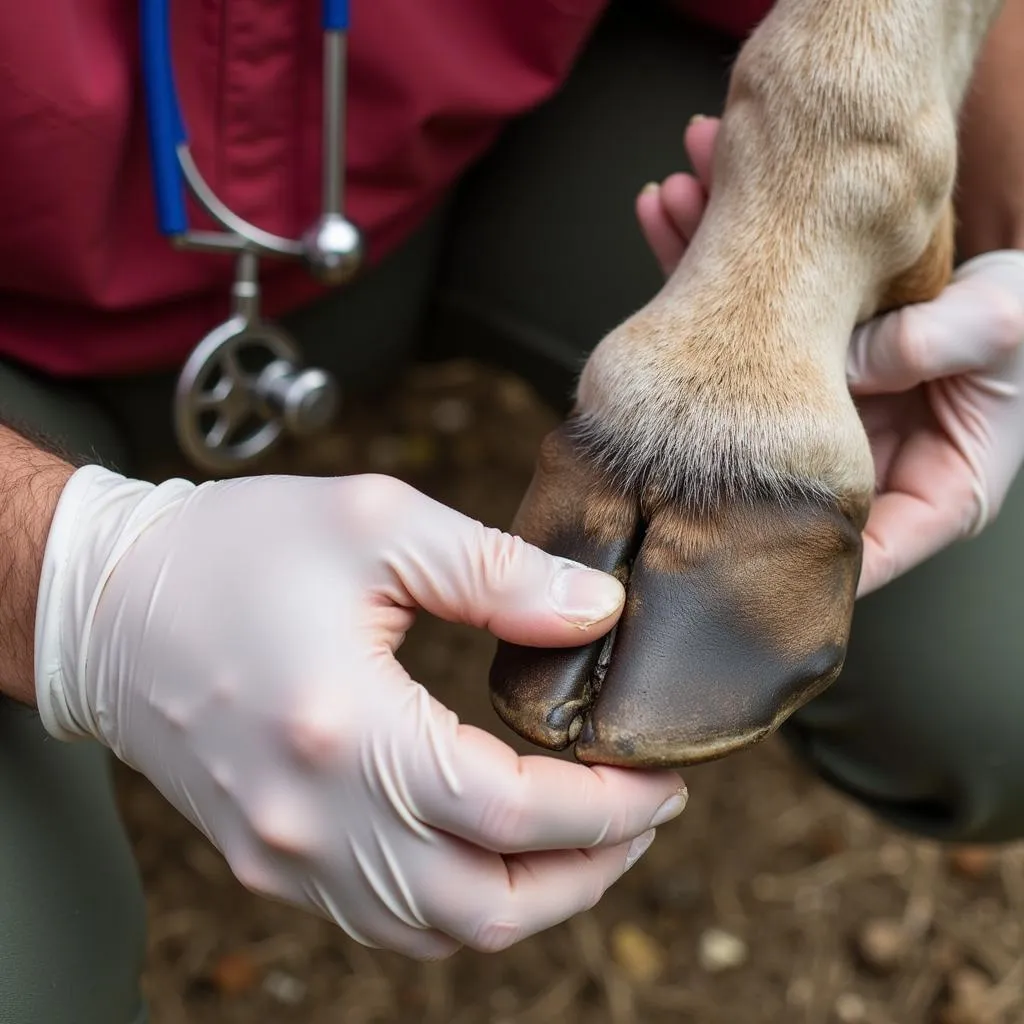A Sheared Heel Horse might sound like a fashion statement, but it’s actually a common hoof conformation issue. This condition, where one side of the heel is lower than the other, can impact a horse’s movement and overall well-being. If you’ve noticed uneven heel height in your equine companion, understanding the causes, potential problems, and solutions is essential for their long-term health and soundness.
What Causes Sheared Heels in Horses?
Sheared heels, sometimes called “uneven heels,” can stem from various factors. Here are some of the most common culprits:
- Improper Trimming and Shoeing: Inconsistent hoof care, particularly trimming one heel lower than the other, is a primary cause. Over time, this can create a significant imbalance.
- Genetics: Some horses are genetically predisposed to sheared heels. Conformation flaws passed down through breeding lines can make them more susceptible.
- Trauma or Injury: An injury to the hoof, such as a puncture wound or abscess, can disrupt normal hoof growth and lead to sheared heels.
- Natural Imbalance: Horses can develop uneven heels simply from how they distribute their weight or move. Factors like conformation in other leg structures can contribute to this.
 Close-up of a horse hoof with sheared heel
Close-up of a horse hoof with sheared heel
Problems Associated with Sheared Heels
Sheared heels are more than just a cosmetic issue. They can lead to a cascade of problems that affect a horse’s performance and comfort:
- Lameness: The uneven weight distribution caused by sheared heels puts stress on joints, tendons, and ligaments, potentially leading to lameness or pain.
- Interference: Horses with sheared heels may interfere, meaning one hoof strikes the opposite leg during movement, causing wounds and discomfort.
- Hoof Cracks: The uneven stress on the hoof wall can increase the risk of hoof cracks, which can be painful and difficult to heal.
- Back Pain: The altered biomechanics from sheared heels can even translate to back pain, as the horse’s entire musculoskeletal system compensates for the imbalance.
Addressing Sheared Heels: Corrective Measures
Fortunately, sheared heels can often be addressed, especially if caught early. Here’s how:
- Corrective Trimming and Shoeing: A skilled farrier or equine podiatrist is crucial. They can employ specific trimming techniques and shoeing methods to gradually realign the hoof and promote balanced growth.
- Therapeutic Shoeing: In some cases, specialized shoes with wedges or pads may be necessary to provide support and encourage the heels to grow evenly.
- Rest and Rehabilitation: Depending on the severity, your veterinarian may recommend a period of rest or controlled exercise to allow the hoof to heal and adapt to the corrective measures.
 A farrier using tools to trim a horse's hoof
A farrier using tools to trim a horse's hoof
Prevention Strategies
Preventing sheared heels is always preferable to treatment. Keep these tips in mind:
- Regular Hoof Care: Schedule trims every 6-8 weeks with a qualified farrier experienced in addressing conformation issues.
- Balanced Diet: Provide a diet rich in essential nutrients, including biotin, to support healthy hoof growth.
- Movement: Encourage regular movement and exercise. Even light turnout can help promote good circulation and hoof health.
When to Consult Your Veterinarian
If you suspect your horse has sheared heels or notice any signs of lameness, contact your veterinarian or a qualified farrier immediately. Early intervention offers the best chance for a successful outcome.
 Veterinarian checking a horse's hoof
Veterinarian checking a horse's hoof
Expert Insight
“Sheared heels are a common issue, but they shouldn’t be ignored,” says Dr. Emily Carter, DVM, an equine veterinarian specializing in lameness. “Early detection and proper management, often through a collaborative effort with a farrier, are key to preventing long-term problems and keeping your horse comfortable and sound.”
By understanding the causes, potential consequences, and solutions for sheared heels, you can help your equine companion enjoy a healthier and more comfortable life. Remember, regular hoof care, a balanced diet, and consistent monitoring are essential for maintaining optimal hoof health.
Need Help?
If you have any concerns about your horse’s hoof health or need assistance with sheared heels, please don’t hesitate to contact us. At Justus Horses USA, we’re dedicated to providing expert care and advice to help your equine companions thrive.
Call Us: 0772127271
Email: [email protected]
Visit Us: QGM2+WX2, Vị Trung, Vị Thuỷ, Hậu Giang, Việt Nam
Our team is available 24/7 to answer your questions and provide support.